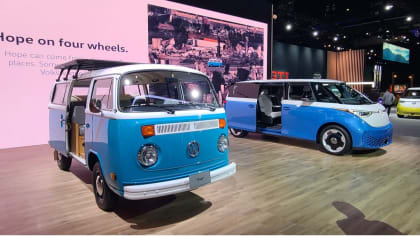MEET THE NEW, NEW VW MICROBUS
This article is from our archives and has not been updated and integrated with our "new" site yet... Even so, it's still awesome - so keep reading!
Published on Wed, Mar 2, 2011
By: The LACar Editorial Staff

HOT WIRE
New compact van concept has pure electric drive
The Volkswagen bus debuted in 1950 with a contagiously simple design. Its internal Volkswagen code name was T1 for Transporter 1. The Germans called it the Bulli, and to Americans it was the Microbus.
Ten years ago, the vision of a new Bulli led to a concept vehicle known as the Microbus. That concept received a grat reception from both the press and the people, but VW never carried it out.
VW says the time is right, now that the necessary, sustainable technologies are at hand. More compact and affordable than the earlier concept vehicle, the newest Microbus is now being shown in Geneva. The new Bulli is powered by an electric motor and fitted with six seats and an infotainment control via iPad.

186.4 miles on a single battery charge
The Bulli being shown in Geneva is what is designated a zero emissions vehicle—that’s because the concept is electrically powered. The Bulli’s electric motor outputs 85 kW of power and 199 pound-feet of torque at 1 rpm. As is usual with this type of drive, its maximum forces are generated from a standstill. The motor is supplied with energy from a lithium-ion battery with a maximum storage capacity of 40 kWh. This combination enables driving ranges of up to 186.4 miles, according to VW. Moreover, VW claims that when the Bulli’s battery is charged at an “electric refuelling station” specially designed for electric vehicles, the charging process takes less than one hour.
The new Bulli is said to accelerate from 0 to 62 mph in 11.5 seconds, with a top speed of 87 mph (electronically limited).
VW says the concept can also incorporate the manufacturer’s efficient gas and diesel direct injection engines as alternative drives. Engines with 1.0 or 1.4 liter displacement that are fuel efficient yet strong; this is downsizing by the book.

Design
The new edition of the Bulli is 156 inches long, 68.4 inches wide and 66 inches tall. The T1 was somewhat longer and taller, but narrower. With a wheelbase of 102 inches, the Bulli utilizes the overall length very well. Also striking here are the Bulli’s relatively large track widths (54 inches front and rear) in relation to body width.
Front end: Like the Samba bus before it, the Bulli being presented in Geneva also has two-tone paint – in this case white and red. The “V” on the bonnet, is kept white. The bonnet does house the engine: instead of rear-wheel drive with a boxer engine, as on the Samba, the Bulli has an electric motor located forward of the front axle and front-wheel drive. Here, it is a compact integral drive whose primary components are an E-motor, high-voltage pulse inverter and DC/DC converter for the 12-Volt electrical system.
In keeping with the Volkswagen design DNA, there is a horizontal layout of the narrow dual headlights with L-shaped LED daytime running lights and turn indicators implemented as LEDs arranged in an inverted L shape at each outer corner. Incidentally, LEDs not only exhibit tremendous luminous power and long life; due to their low energy consumption, they are ideal for the electrically powered Bulli of 2011. Located between the headlights in the bonnet is, as always, the VW logo. On the level beneath, one finds – once again arranged in a horizontal line – the air intakes for the passenger compartment and for battery cooling or for cooling the alternative conventional drives.
Side profile: The Bulli’s two-tone paint also distinguishes the sides. Treated in white is the entire area above what is known as the character line. Originating in the wings is a white stripe that runs to the distinctive D-pillars; above them, the entire roof section is painted in this color. The continuous line of windows creates an especially striking contrast between the white sections. Here, the visually slender black pillars executed in the style of the 2001 Microbus concept are visually striking. Painted in red are the door mirror housings protruding from the line of windows.

Interior space – melding of car and iPad
Like the body design, the interior harbors some surprises. For one, the passenger compartment is immersed in light during the day, thanks to its panoramic sunroof. A practical highlight: like the T1 in times past, thanks to its level floor, the new Bulli is also equipped with a single bench seat in front. The van offers space for three in the rear as well.
An infotainment highlight: a removable iPad in the center console serves as a multifunctional touchscreen. Along with Internet-based iPad applications and the media center, it also handles control of such functions as Bluetooth hands-free telephone and a navigation system. Integrated right on the iPad mount are controls for the climate control system and the centrally-located hazard warning switch.
A color multifunction display, also semi-circular in shape, can be used to view and control (via multifunctional keys in the steering wheel and on it) the navigation system, telephone, trip computer and media center – the entire unit of speedometer and multifunction display also communicates with the iPad. A sound system produced by guitar and amplifier manufacturer Fender (USA) is integrated into the Bulli concept.
What is not found in the Bulli is a tachometer (unnecessary with an electric motor) or a conventional gear shift or gear selection lever (also unnecessary with an electric motor). The latter is replaced by a rotary switch to the right of the driver, which is used to activate forward and reverse gears. A push button in the same switch is used to start and stop the motor. Another rotary switch to the left of the driver is used to control the lighting functions.

Seats become reclining surface
The outer and middle seat positions of the front bench seat can be folded down (2/3 split); the rear beach seat, meanwhile, can be completely stowed. When the rear bench seat is stowed, cargo capacity increases to 1,600 liters. In addition – and here the new Bulli is reminiscent of its ancestor – the seat system can be transformed into a large reclining surface with just a few manual movements. This turns the compact MPV into a compact camper.
At least as important for many users, however, is that the seating system should not only be versatile but also offer maximum comfort. VW claims that the seat position is comfortably high and relaxing. As an added benefit, it offers an optimized view forward. And that is how it was in the T1 too. Contributing to peace of mind aboard today’s vehicle is the fact that the new era Bulli is equipped with all conceivable safety features. And that, according to VW, is the crucial difference: the car has essentially been reinvented since the days of the first T1 aka the Bulli aka the Microbus.




